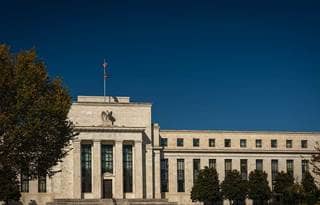Today’s announcement from the Federal Reserve delivered policy fine-tuning as expected, providing a quarter percent cut in its benchmark policy rate as expected.
More surprising was Fed Chair Powell’s subsequent remarks that threw cold water on expectations that policymakers are similarly teed up for another 25-basis-point cut at their December policy meeting. That undercut widely held expectations for additional easing before year-end in line with the Fed’s September projections.
A December cut is still a possibility, but Powell’s cautionary tone cast the decision in a different light than the near certainty that had been priced into the futures market prior to today’s press conference.
In its statement, policymakers characterized the economy’s current state as being consistent with moderate growth, while acknowledging the contrasting risks to the near-term outlook. Inflation has edged up and remains above the Fed’s target, but the growing risk emerging from slower job creation has added a meaningful wrinkle to the Fed’s policy calculus.
It's no longer possible for the Fed to focus solely on positioning policy to rein in inflation; the risk of a further slowdown in job creation has moved the needle on relative risks toward a need to ease policy. How much and how quickly remain open questions though.
While estimates of neutral rate policy have edged higher in recent years, current policy — even after today’s cut — remains moderately restrictive. That leaves further room for the Fed to trim into next year if inflation pressures ease or if labor market conditions deteriorate more notably.
Today’s policy announcement was also accompanied by word that policymakers are ready to bring an end to their multiyear quantitative tightening campaign of balance sheet reduction. That should help to provide a degree of stability for the banking system, where some limited cracks have emerged, suggesting undesired tightness in money markets. The Fed now shifts toward controlled balance sheet expansion roughly aligned with nominal GDP growth, alleviating that pressure.
The government shutdown layers an additional risk onto an already challenging stack of considerations for policymakers. While the shutdown that started earlier this month sidelined most government-produced economic data in recent weeks, the Fed can lean on other analytics and private-sector data for guidance, albeit imperfect and incomplete.
However, the longer the shutdown extends, the greater the risk. Arguably, the Fed isn’t currently flying blind, but there’s no doubt their vision is much more limited at this juncture. The longer the flow of reliable government data on labor, inflation, consumption, and growth is interrupted, the more occluded their ability to forecast reliably becomes, raising the risk of a potential policy misstep.
The bottom line? The policy relief delivered by the Fed today was in line with expectations and would’ve been well received by investors on its own merits. Powell’s cautionary note that a December rate cut shouldn’t be viewed as a foregone conclusion elicited a much more cautious response from the markets. One more cut before 2026 could still come, but Powell’s “not so fast my friends” message wasn’t lost amid otherwise accommodative policy developments. That was a surprise for investors, who’ll now have to recalibrate their expectations accordingly.
Past performance does not guarantee future results. All investments include risk and have the potential for loss as well as gain.
Data sources for peer group comparisons, returns, and standard statistical data are provided by the sources referenced and are based on data obtained from recognized statistical services or other sources believed to be reliable. However, some or all of the information has not been verified prior to the analysis, and we do not make any representations as to its accuracy or completeness. Any analysis nonfactual in nature constitutes only current opinions, which are subject to change. Benchmarks or indices are included for information purposes only to reflect the current market environment; no index is a directly tradable investment. There may be instances when consultant opinions regarding any fundamental or quantitative analysis may not agree.
Plante Moran Financial Advisors (PMFA) publishes this update to convey general information about market conditions and not for the purpose of providing investment advice. Investment in any of the companies or sectors mentioned herein may not be appropriate for you. You should consult a representative from PMFA for investment advice regarding your own situation.





